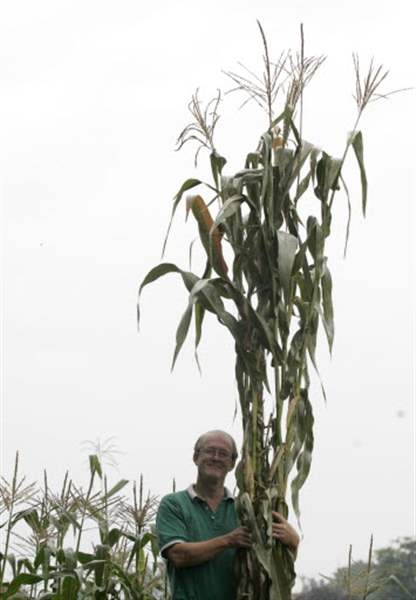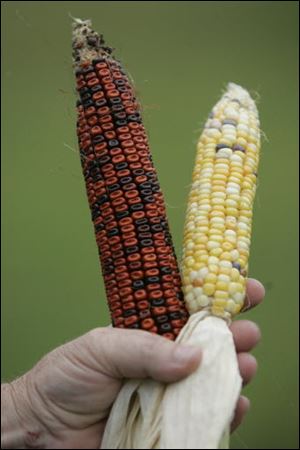
Toledoan's corn experiment becomes lesson for grandchildren
8/25/2010
Rex Browns shows just how tall his corn stalks have grown this year.

Rex Browns holds two of his varieties of Indian corn that he grows in his Toledo backyard.
The garden is always a great spot for generations to come together. Recently, a grandfather taught his grandchildren a bountiful lesson about the power of a kernel of corn.
Toledoan Rex Browns says the project started with just three ears of Indian corn. The corn now reaches up to 12 feet tall.
“I did not buy it for decoration but in my mind. I was going to use it for some quality time with my grandchildren, 4 and 5 years old,” he said.
For a lesson in patience and matching skills, he and his two grandchildren separated the kernels by color —red, brown, and mixed — and the three of them spent an hour shelling the kernels from the cob. Each color went into a separate plastic bag, and Mr. Browns tucked them away in his garage for the winter.
A good start is what any garden needs, and it reinforces the lesson that your plants require a fertile foundation to thrive. Mr. Browns enhanced his sandy soil with grass clippings and mulched leaves. He started planting in mid-May.
“When I planted the corn, I sprinkled Azomite, a mineral enhancer and 12-12-12 fertilizer.” He says this product was tough to find but he ordered it via the Internet.

Rex Browns shows just how tall his corn stalks have grown this year.
Mr. Browns planted five rows of corn, each 20 feet long, in the spring.
“The kernels were planted about five inches apart in the rows. Each row was divided into thirds. The red kernels were planted [on one end]. In the middle were the brown kernels, and the west end of the rows were the yellow kernels. This was done so I would get a mixture of different-colored ears due to the wind pollination of the corn tassels,” he said.
Also known as calico or flint corn, Indian corn is primarily grown for decoration today. Native Americans used it as a staple in their garden for generations.
Blue Indian corn can be ground to make blue flour and strawberry Indian corn can be shelled and used as popcorn.
If you buy Indian corn at the store, like Mr. Browns did, make sure it isn't coated with any preservative or polyurethane. These products can stop your seed from growing once planted.
Indian corn can be planted just like any other corn, using the seeds from a previous crop to grow a new one, just like Mr. Browns and his grandchildren did. Keep the corn planted in compact rows so it can easily pollinate in the wind. Make sure Indian corn isn't planted near sweet corn in the garden, or cross-pollination will occur and your sweet corn won't taste as sweet and will take on some of the starchy qualities of the Indian corn.
Now that some of the corn reaches more than 12 feet, Mr. Browns and his grandchildren learned that good seed and good soil will produce outstanding plants.
“Right now I have measured the tallest stalk at 12 1/2 feet. Several others are topping out at 12 feet," he said.
"I am amazed at the height of the corn stalks. One ear is measuring about 15 inches from the stalk to the silk end of the ear. I cannot reach and touch the top of one of the ears because it is growing up so high on the stalk. There may be more like this but I have not found them yet.”
Persistence is the last lesson for Mr. Browns' grandchildren.
Once the silks turn brown, the corn is ready to harvest. Pull the husk off the cob, hang it up to dry for a few days, and it is ready to use as a decoration or a seed for a new generation. And they can learn about the whole life cycle of Indian corn at their grandpa's side again next spring.
Contact Kelly Heidbreder at:
kheidbreder@theblade.com